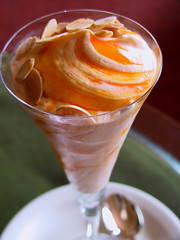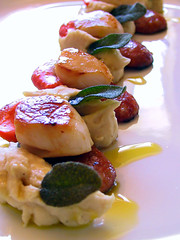Apricot, my favourite colour in roses, gives a dreamy dimension to desserts. It’s amazing what a dash of yellow can do for the ubiquitous princess pink; giving it an elegance and soft richness that’s very enticing. Cecile Brunner, the little buttonhole rambling rose, is deservedly popular, but its cousin the softly apricot Perle d’Or (golden pearl) is, as its name suggests, in another realm.
Fruit fools are the pearls of English puddings but they’ve fallen out of favour in this era of being bludgeoned over the head by sticky date puddings, mostly soggy lemon tarts and over-sized muffins. A touch of class, as an antidote to all that crassness, is what’s required. A fruit puree folded through whipped cream and turned into a pretty glass vessel is an appealingly light and delicate sweet end to a grand meal. The method is simple enough too for family treats at any time.
Choose a fruit that has an intense flavour, preferably with a good acid backbone. Blackberries, raspberries, gooseberries (one of the best), damson plums, greengages and apricots all make delicious fruit fools. The basis of the dessert is to prepare a dense puree of cooked fruit. You can do this well ahead as it is best if the puree is very cold when folded into the whipped cream. That way the fool will hold is soft shape perfectly without collapsing. It is worthwhile sieving the puree to remove any excess seeds or hard pieces of skin.
Here I’ve used the last of this season’s apricots. To make sure the puree has plenty of oomph use the smallest amount of water possible to cook the fruit without it sticking to the bottom of the pan. This rule also applies to all the other fruits listed above. When apricots are out of season you can use dried to excellent effect. Simply soak in a little warm water until they’ve swelled and softened and then cook them as you would the fresh apricots. They may need a little extra sugar so taste the finished puree. Tiny meringues or crisp dessert biscuits are lovely with fools.
A delicately flavoured dessert needs a delicate dessert wine that’s not too sticky and sweet. Try Wellington’s Iced Riesling.
The Recipe
Apricot fool (fills 4-5 glass flutes)
300g fresh apricots, halved and stoned
2 tbsp water
2 tbsp caster sugar (or more to taste)
lemon juice to taste
300ml thickened cream
1 tbsp icing sugar
flaked almonds, toasted in oven for five minutes
Place the apricots in a heavy-bottomed saucepan with the sugar and water. Cook very gently, stirring occasionally, until the apricots are very soft. Puree the contents of the saucepan in a food processor or blender until smooth. Pass through a medium-holed mesh sieve to remove any hard pieces of skin. If the puree seems sloppy at this point you can pop back in a clean saucepan and gently simmer to evaporate any excess water. Keep stirring to stop it from sticking. Add enough lemon juice to bring out the flavour and check for sweetness. Chill.
Whip the cream to soft peaks with the icing sugar. Fold the apricot puree into the cream in a figure of eight, keeping some swirls of puree evident in the mixture for a pretty effect.
Pour into glass vessels. Top with the toasted almonds.


